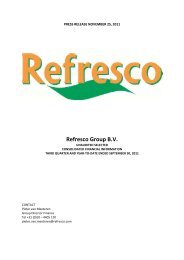measure and monitor the processes and report results ... - Refresco.de
measure and monitor the processes and report results ... - Refresco.de
measure and monitor the processes and report results ... - Refresco.de
You also want an ePaper? Increase the reach of your titles
YUMPU automatically turns print PDFs into web optimized ePapers that Google loves.
present value of <strong>the</strong> minimum lease payments. Subsequent<br />
to initial recognition, <strong>the</strong> asset is accounted for in accordance<br />
with <strong>the</strong> accounting policy applicable to that asset.<br />
O<strong>the</strong>r leases are operating leases <strong>and</strong> are not recognized on<br />
<strong>the</strong> consolidated balance sheet.<br />
2.9 Inventories<br />
Inventories are <strong>measure</strong>d at <strong>the</strong> lower of cost <strong>and</strong> net realizable<br />
value. The cost of inventories is based on <strong>the</strong> firstin firstout<br />
method, <strong>and</strong> inclu<strong>de</strong>s expenditure incurred in acquiring <strong>the</strong><br />
inventories, production <strong>and</strong> conversion costs <strong>and</strong> o<strong>the</strong>r costs<br />
incurred in bringing <strong>the</strong>m to <strong>the</strong>ir existing location <strong>and</strong><br />
condition. The cost of finished goods <strong>and</strong> work in progress<br />
inclu<strong>de</strong>s an appropriate share of production overheads based<br />
on normal operating capacity. Net realizable value is <strong>the</strong><br />
estimated selling price in <strong>the</strong> ordinary course of business, less<br />
<strong>the</strong> estimated costs of completion <strong>and</strong> selling expenses.<br />
2.10 Impairment<br />
Financial assets<br />
Financial assets are assessed at each <strong>report</strong>ing date to <strong>de</strong>termine<br />
whe<strong>the</strong>r <strong>the</strong>re is any objective evi<strong>de</strong>nce that it is impaired.<br />
A financial asset is consi<strong>de</strong>red to be impaired if objective<br />
evi<strong>de</strong>nce indicates that one or more events have had a negative<br />
effect on <strong>the</strong> estimated future cash flows of <strong>the</strong> asset.<br />
Impairment losses in respect of financial assets <strong>measure</strong>d at<br />
amortized cost are calculated as <strong>the</strong> difference between <strong>the</strong><br />
carrying amounts <strong>and</strong> present values of <strong>the</strong> estimated future<br />
cash flows discounted at <strong>the</strong> original effective interest rate.<br />
An impairment loss in respect of an availableforsale financial<br />
asset is <strong>measure</strong>d by reference to its fair value.<br />
Individually significant financial assets are tested for impairment<br />
on an individual basis. The remaining financial assets are<br />
assessed collectively in groups that share similar credit risk<br />
characteristics. Impairment losses are recognized in profit or<br />
loss. An impairment loss is reversed if <strong>the</strong> reversal can be<br />
related objectively to an event occurring after <strong>the</strong> impairment<br />
loss was recognized. For financial assets <strong>measure</strong>d at amortized<br />
cost <strong>the</strong> reversal is recognized in profit or loss.<br />
Nonfinancial assets<br />
The carrying amounts of nonfinancial assets, o<strong>the</strong>r than<br />
inventories <strong>and</strong> <strong>de</strong>ferred tax assets, are reviewed at each<br />
<strong>report</strong>ing date to <strong>de</strong>termine whe<strong>the</strong>r <strong>the</strong>re is any indication<br />
of impairment. If any such indication exists, <strong>the</strong>n <strong>the</strong> asset’s<br />
recoverable amount is estimated. For goodwill <strong>and</strong> intangible<br />
assets that have in<strong>de</strong>finite lives or that are not yet available<br />
for use, <strong>the</strong> recoverable amount is estimated annually.<br />
The recoverable amount of an asset or cashgenerating unit is<br />
<strong>the</strong> greater of its value in use <strong>and</strong> its fair value less costs to<br />
sell. In assessing value in use, <strong>the</strong> estimated future cash flows<br />
are discounted to <strong>the</strong>ir present value using a pretax discount<br />
rate that reflects current market assessments of <strong>the</strong> time value<br />
of money <strong>and</strong> <strong>the</strong> risks specific to <strong>the</strong> asset. For <strong>the</strong> purpose<br />
of impairment testing, assets are grouped at <strong>the</strong> lowest levels<br />
for which <strong>the</strong>re are separately i<strong>de</strong>ntifiable cash flows from<br />
continuing use that are largely in<strong>de</strong>pen<strong>de</strong>nt of <strong>the</strong> cash flows<br />
of o<strong>the</strong>r assets or groups of assets (<strong>the</strong> “cashgenerating units”).<br />
For <strong>the</strong> purpose of impairment testing, <strong>the</strong> goodwill acquired in<br />
a business combination is allocated to cashgenerating units that<br />
are expected to benefit from <strong>the</strong> synergies of <strong>the</strong> combination.<br />
An impairment loss is recognized if <strong>the</strong> carrying amount of<br />
an asset or its cashgenerating unit exceeds its estimated<br />
recoverable amount. Impairment losses are recognized in<br />
profit or loss. Impairment losses recognized in respect of<br />
cashgenerating units are allocated first to reduce <strong>the</strong><br />
carrying amount of any goodwill allocated to <strong>the</strong> units <strong>and</strong><br />
<strong>the</strong>n to reduce <strong>the</strong> carrying amount of <strong>the</strong> o<strong>the</strong>r assets in <strong>the</strong><br />
unit (or group of units) on a pro rata basis.<br />
An impairment loss in respect of goodwill is not reversed.<br />
In respect of o<strong>the</strong>r assets, impairment losses recognized<br />
in prior periods are assessed at each <strong>report</strong>ing date for<br />
indications that <strong>the</strong> loss has <strong>de</strong>creased or no longer exists.<br />
An impairment loss is reversed if <strong>the</strong>re has been a change in<br />
<strong>the</strong> estimates used to <strong>de</strong>termine <strong>the</strong> recoverable amount.<br />
An impairment loss is reversed only to <strong>the</strong> extent that <strong>the</strong><br />
asset’s carrying amount does not exceed <strong>the</strong> carrying amount<br />
that would have been <strong>de</strong>termined, net of <strong>de</strong>preciation or<br />
amortization, if no impairment loss had been recognized.<br />
page _ 68 / 69







